Competitive SEO
The Professional's Guide to SEO: How to rank in a highly competitive niche
Attorney, insurance, hotels… in this chapter, we’re talking all about SEO for highly competitive niches. This brand of SEO is not for the faint of heart. It demands innovation. It doesn’t let you stop working. If you’re responsible for the organic success of a website in a competitive niche, this is the chapter for you.

Define “competitive”
For the purposes of this chapter, when we refer to “competitive,” we mean websites vying for placement on the SERPs saturated with the most authoritative websites. Highly competitive brands are pursuing high-value, popular, bottom-of-funnel keywords, and those SERPs are incredibly difficult to break into.
Let’s look at the keyword “attorney” as an example:
This is a high-value keyword, as attorney fees typically range from $200 to $400 per hour
It’s a popular keyword, with a volume of approximately 98k searches per month
It’s a bottom-of-funnel keyword, as the intent implies that the searcher is ready to hire an attorney
So how do we determine what a “highly competitive” keyword is in a quantitative, objective way? At Moz, we’ve created a metric for determining how hard the average website will have to work to rank on page 1 for a given keyword. That metric is Keyword Difficulty.
Keyword Difficulty is on a scale of 1-100, where a score of 1 is very easy, and 100 is very difficult. It’s based on the Page Authority (PA) and Domain Authority (DA) scores of the websites currently ranking on page 1 for a keyword. If those ranking websites have high PA and DA scores, it will increase the Difficulty score of a keyword.
If you’re asking yourself: What’s a good Difficulty score? Well, the answer varies depending on your website’s competitive edge. However, here’s a general guide on how the Difficulty score of a keyword corresponds to a keyword’s competitiveness (how difficult it is to rank):
0–20 - Very low
20–35 - Low
36–50 - Average
51–65 - Difficult - at this level your site requires some authority, and you’ll need a powerful strategy
66–80 - Very difficult
81 - 100 - Nearly unattainable, unless you are eBay, Etsy, Amazon, Wikipedia, or similar
Another factor you may want to consider when evaluating a keyword’s competitiveness is the Google Ad cost. Keywords with high cost-per-click (CPC) can sometimes indicate that there is high organic competition for that term.
You could also look at the estimated monthly search volume. In most cases, the higher the search demand (higher searches per month), the more competition there is to capture those searches. That is why you’ll often see Keyword Difficulty directly proportional with monthly search volume.
How geography impacts competitiveness
Businesses with a local presence must also factor in geography in addition to sheer keyword metrics. Google search results are highly personalized, particularly for keywords with local intent. That’s because, over the last few years, local searches without a “near me” qualifier have grown 150%. According to Google’s Lisa Gevelber, people expect local personalization:
Several years ago... if someone wanted to find a sushi restaurant nearby, their search query would likely include the zip code, area name, or even “near me.” Today, people expect brands to gather enough contextual information to deliver location-specific responses without someone having to search for anything more than just “sushi.”
“Vegan restaurants” might be a highly competitive term in San Francisco, but much less so in Omaha, so don’t stop at Difficulty score or keyword volume. You have to evaluate the local landscape. How many other local businesses are there that do what you do? Local, real-world competition can impact digital competitiveness.
When to fight, when to fold
SEOs like a challenge. No surprise there. There are, however, some cases in which it might not be wise to go after that highly competitive keyword.
SERP is dominated by big brands: Unless you’re Wikipedia, The New York Times, or Amazon, fighting for some keywords is a matter of diminishing returns. If the SERP for your chosen keyword is dominated by sites like that, and you’re a smaller shop or just starting out, it might be wise to select some longer-tail, slightly less competitive terms.
SERP is dominated by special features: If you want your website to rank on page 1 for a keyword, but the SERP for that keyword is dominated by features like the Shopping Carousel and Knowledge Panels, there’s less likelihood your website will get clicked on even if it does appear on page 1. In Moz’s Keyword Explorer, type in your desired keyword and view its “Organic CTR.” The lower the percentage, the less opportunity you’ll have to get clicks due to SERP features.
SERP indicates intent doesn’t match: Just because a keyword has a high search volume doesn’t necessarily mean that you want to target it. Google your keyword and see what is showing on the SERP. Are there directories and lists (“The 10 Best Pizza Places in New York”)? Commercial results (ex: shopping ads)? “Refine by” features indicating ambiguous intent? If the results don’t match the type of content your page is providing, the keyword probably isn’t a good opportunity.
“Fold” might be a little harsh. “Pivot” might be more accurate. Be willing to let certain keywords go in lieu of gaining share of SERP for your market in other ways. Target longer-tail, lower-competition keywords or focus on getting your website listed on the sites that are ranking for your desired keywords. These long-tail, top-of-funnel keywords are further from the point of purchase, but often have lower Difficulty scores (and therefore, are easier to rank on page 1)!
Let’s say, for example, that your website is trying to rank for the keyword “attorney.” This keyword has a Difficulty score in the 60’s, and if you are managing a website for a small law firm with a low Domain Authority, this would be a difficult SERP to break into. Instead of folding, considering pivoting - by targeting less competitive keywords at the top of the funnel. As you can see, as you progress through the sales funnel, the competition, as indicated by the Difficulty score, increases.
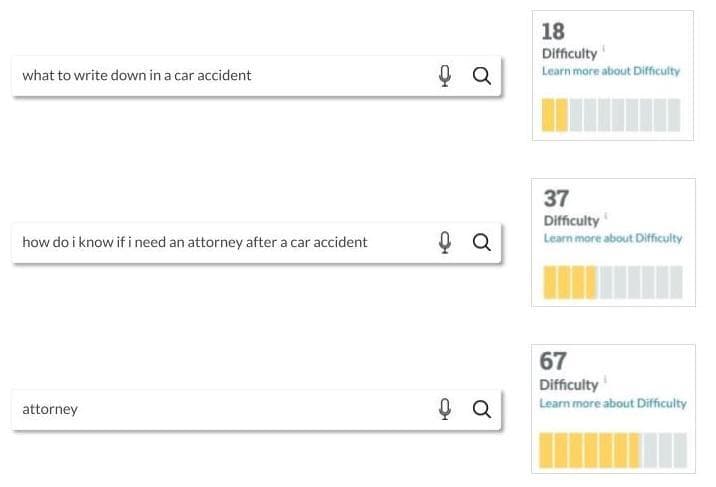
For more information on choosing and prioritizing keywords for your campaign, check out this Whiteboard Friday.
Read on for actionable tips for breaking into competitive SERPs.
1. Stop! Do you have a strong technical foundation?
Yes, we’re starting our section on competitive SEO with a warning. While every site should have a strong technical foundation — crawlable, indexable, accessible, efficient, etc. — the implication of errors increases in proportion to the competitiveness of the query.
You could select the perfect topic through keyword research, create engaging, optimized content that matches the searcher’s intent, and bolster your page’s authority through internal linking and backlinks from high quality sites. But none of that will make a difference if you don’t have a strong infrastructure in place. Entering the competitive niche race will require a solid technical head start! If you're ready to elevate your technical SEO knowledge and improve your website, we recommend reading and downloading the Technical SEO Checklist. This list covers all the important areas around indexing, ranking, and visibility in the Google search results based upon our years of in-depth SEO knowledge in the industry.
2. Identify your competitors
It’s essential to understand who your true competitors are. Chasing the wrong competitors could be misshaping your SEO strategy (and wasting your time and money!), and your real-world, physical competitors are not always the same as your digital competitors. Your digital competitors are those brands who target the same segments, provide a similar set of products at comparable prices, and most importantly, rank for your target keywords. That’s not to say you shouldn’t keep tabs on your real-world competitors, but for the sake of knowing who you’re vying for SERP visibility against, domains ranking in the top spots for your most important keywords is where you should look when identifying your competitors.
If you’re aware that you’re in a competitive niche, we’re going to assume you’ve already developed a keyword strategy, and have discovered the keywords you want to pursue. Once you’ve established your target keywords, you’re ready to identify your digital competitors.
The process of identifying competitors can be a long and arduous one. You’ll need to:
Search each of your target keywords, grouped by topic/product/service
Collate the SERP results
Repeat for each keyword
Identify domains that repeatedly appear
You then need to repeat the process for each product and service you offer. AND, on top of that, if you have target content topics, you'll perform competitor research for those keywords as well, and that may produce a whole new set of results.
PHEW.
However, you can take shortcuts with the Moz True Competitor tool. In the left-hand menu, click True Competitor. Enter your domain:
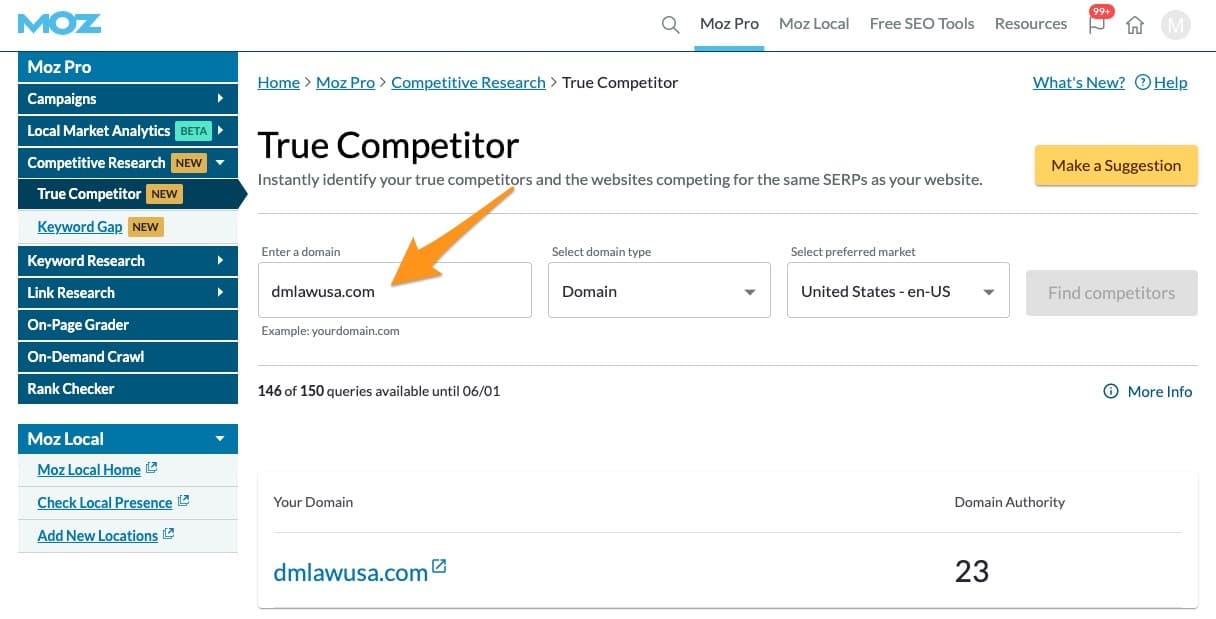
And in seconds, you’ll be given a list of the top 25 competitors for that domain:
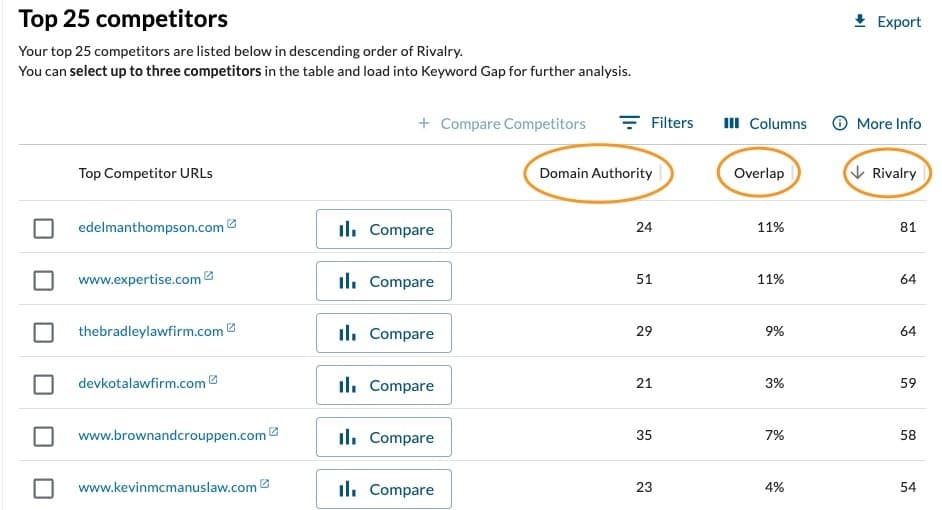
For each competitor listed, you'll also see:
Domain Authority: a Moz metric, on a scale of 1 to 100, that predicts how well a website will rank, based on the quality and quantity of backlinks to a website
Overlap score: the percentage of keywords that you share with that competitor
Rivalry score: a score on a scale of 1-100 that combines your DA, your competitor's DA, Overlap score, keyword volume, and your rankings to give you one powerful way of identifying your biggest rivals
Knowing who your competitors are is just the beginning of competitive analysis, but it’s an essential undertaking as a professional SEO. It will help you better understand your market, and adapt your digital strategy accordingly.
3. Reverse-engineer strategy through competitor analysis
Now that you’ve identified your competitors, you can start to dig into the source of their SERP success. Conducting a competitor analysis is a key step in informing your SEO strategy so that you can be successful for highly-competitive keywords.
Most pages listed in the top spots for competitive queries have a few things in common:
Brand: Google may not have an outright brand bias, but top-ranked sites in competitive niches tend to belong to large brands with high recognition.
Links: Many inbound links from quality websites still move the needle for organic search rankings, although the link signal is now tempered more by other signals such as...
Relevance: Top-ranked sites in competitive niches tend to capture intent really well. That means their content quality and the way their content is structured fully satisfies what the searcher set out to accomplish.
Topical authority: Sites that perform really well for competitive queries have established themselves as authorities in certain topics. They publish expert content on the topic and send really consistent messages to Google about the topic of their site.
You might find that your competitors are getting a lot of press, or that they’re earning a lot of links to informational content. Insights like these can help steer you toward the strategies you need to succeed in these competitive SERP landscapes.
Analyzing your competitors can help you improve your own site by allowing you to understand what they do well — what’s helping them in search rankings — and then improving upon their strategy. By analyzing the content your competitors are creating, you’ll discover content trends in your industry, and generate new ideas! When we're researching the competition's content, from a holistic, domain-level perspective, we need to look for 3 things:
Your competitors’ top URLs
Content format
Content type
Once you’ve identified your competitors’ most successful content, the key is to not simply recreate your competitor's content (that would have little chance of success), but to significantly improve upon it. You could:
Answer additional questions related to the topic
Employ multiple formats for different types of learners
Harness internal, proprietary data that can’t be found elsewhere
Create stunning visuals, such as infographics or instructional images
Provide examples to connect your audience to a real-world scenario
Improve the user experience by increasing page load time
Include actionable steps that readers can put into practice
Don’t forget to entertain!
Add any element to make it more appealing or useful
For more information on how to conduct a competitor analysis and apply the information you find, we recommend the following articles and resources from Moz:
Reveal your rivals
4. Create content that searchers want
Top-ranked sites in competitive niches have something in common — their content is informed by evaluating what their audience wants, not what they think search engines want.
You can create content that satisfies intent like this too by asking these types of questions during the content ideation and creation process:
Will this content help accomplish one of my goals? What purpose will it serve?
Does this answer a question my audience has? Better than my competitors?
Am I meeting my customer at their appropriate sales funnel stage?
Is this written by an authority on the topic?
Am I formatting my content in the most engaging way possible?
Is my content comprehensive enough to fully address the topic?
Is my content accessible to my entire audience (fast, cross-device friendly, etc.)?
Content that misses the mark can harm your site’s performance in search results as a whole, according to Google, and sites in competitive niches can’t afford to lose even an inch of ground, so enter content creation with the mindset that intent is everything.
One of the most effective ways to understand how a website is succeeding in a competitive niche is by performing keyword gap analysis. Keyword gap analysis is the process of identifying valuable keywords that your competitors rank highly for, which you don't. It enables you to gather insight into the types of things your audience really cares about, and gain inspiration to target new keywords and develop applicable content.
The Moz Pro Keyword Gap tool can save the day here! With this tool, you can compare your domain against competitors to discover content gaps and opportunities.
In the left-hand menu, under Competitive Research, click on Keyword Gap.
Enter your domain, and up to 3 competitors. Click Analyze Competitors.
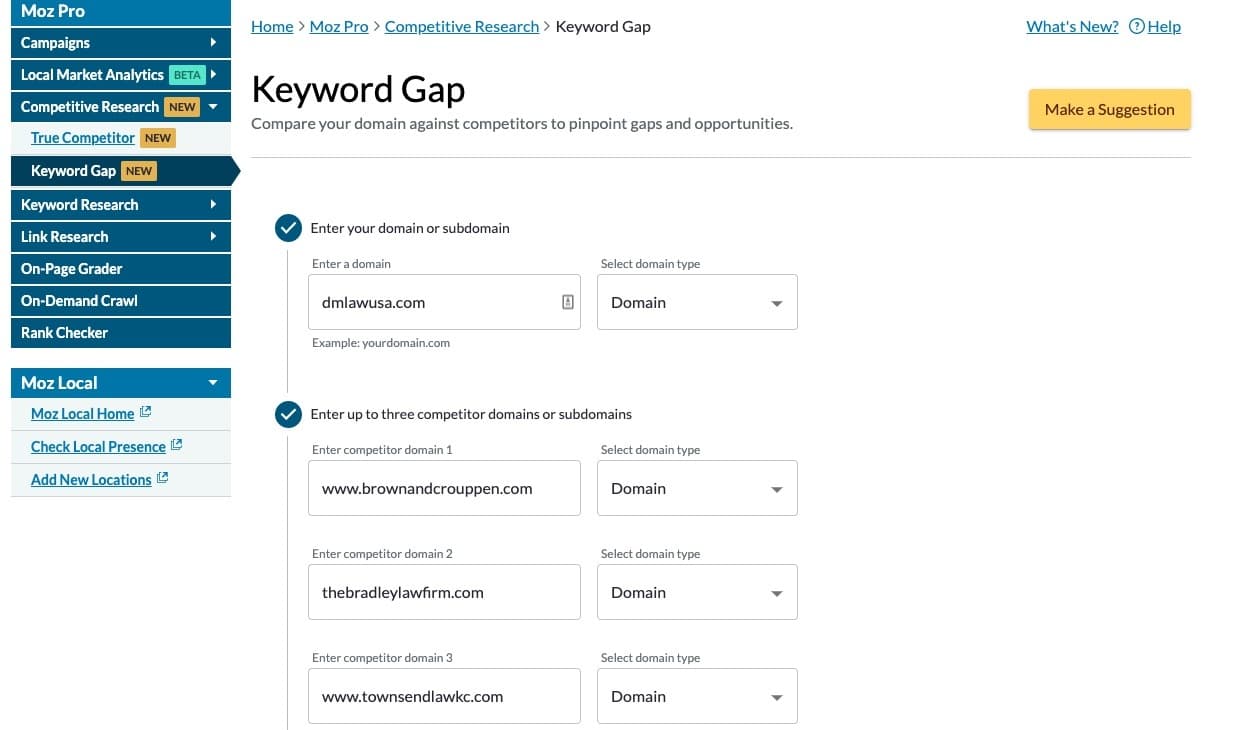
3. Scroll down to Top Competing Content. This is your competitors’ most visible content, and the top keywords that this URL is ranking for.
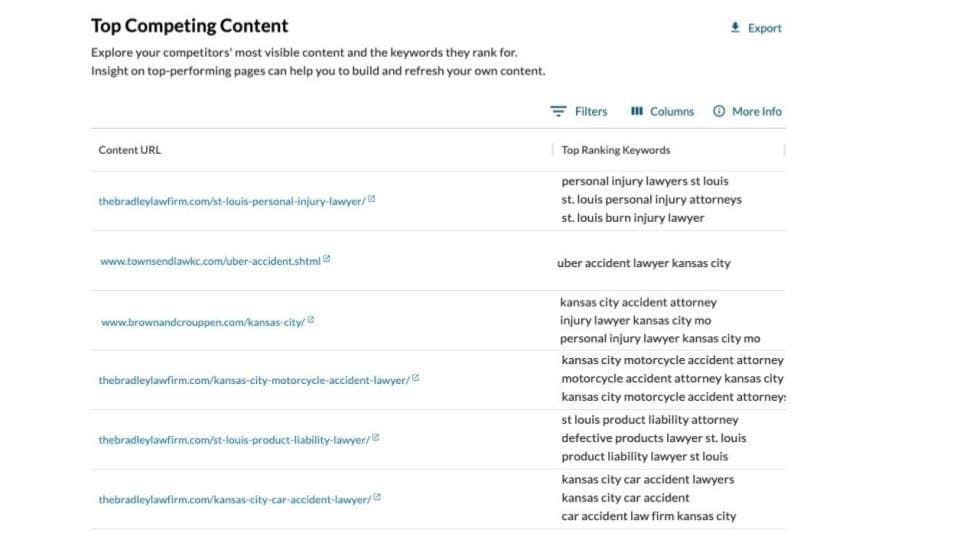
This can help to provide insight into top-performing pages, so you can build and refresh content on your own site.
BONUS: In crowded markets, you can get your content to stand out in the SERP by capturing featured snippet opportunities!
For example, a featured snippet appears for the keyword “what are typical attorney fees”:
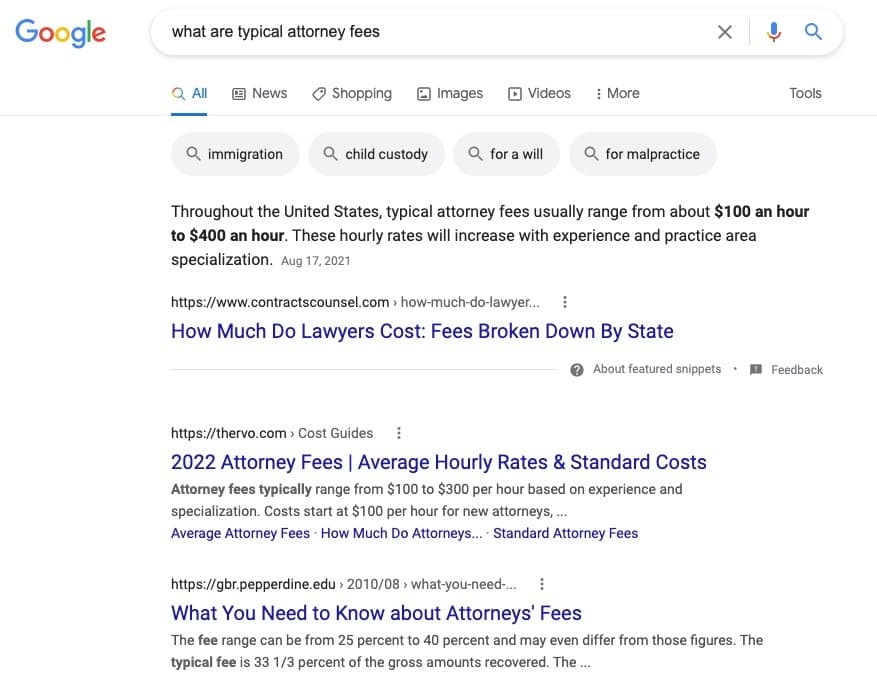
Appearing in the featured snippet gets you visibility over other search results, and also occupies valuable real estate above the traditional search results, drawing the searcher’s eye to your content. Learn more about targeting these opportunities.
5. Putting link building in its place
It seems like sites used to be able to rank for competitive queries even with mediocre content if they had good backlinks. Today, it seems that links don’t make up for weak content. Is that intentional? Experts agree that this is what they’re seeing as well, and it seems to be an intentional shift on Google’s part.
Alexis Sanders put it this way:
Google has a significant economic incentive to provide the best answers (and content) to users. Search is the largest portion of Alphabet's business. Interestingly enough in their10-Q they define the nature of their business as, "We generate revenues primarily by delivering relevant, cost-effective online advertising." This report shows about 86% of their revenue in the first half of 2018 came from "advertising revenue" (Note 2). I guess one could say it's a $54.7 billion semi-annual incentive. All of this to say, we can safely expect that search will continue to be more quality driven.
Are backlinks still important? Absolutely. Backlinks are a crucial prerequisite to enter the competitive niche race. Backlinks demonstrate to Google that you’ve built trust and reliability on the web, and that other websites in your niche are willing to send their audience to your site. If you have lots of links but your content is weak, don’t expect any favors from Google. Quality and relevance are going to increasingly trump traditional link-based signals like quantity of linking root domains.
One thing SEOs can focus on for building links to sites in competitive niches is whether or not the link will accomplish a goal. Sure, getting a link can be a goal in-and-of itself, but you may want to ask yourself — would you pursue the opportunity even if you wouldn’t get a link out of it? The best link opportunities are:
- relevant to your site's content
- useful to the linking site’s readers
- come from sites that offer you exposure to your desired audience
6. Optimize for engagement
Sites highly ranked for competitive keywords tend to be more engaging than lower ranked sites. These sites understand what the user wants and help them do that quickly and easily on any device. Sites are adapting to meet Google’s demand for this type of web experience, turning what used to be a “nice to have” or a “competitive advantage” into table stakes.
It can be helpful to break engagement down into metrics and factors. Metrics measure how searchers are interacting with your site, while factors are objective qualities that can impact the visitor’s experience. For example, page speed (a factor) can influence bounce rate (a metric).
Here are some examples:
| Engagement | Ranking factor? | Application |
|---|---|---|
| Time on site/page (metric) | Moz’s ranking factor study found a correlation between time on site and high rankings, but correlation is not causation, and Google has never confirmed time on site/page as a signal they use to rank pages. | If you have a really in-depth article that has an average time on page of 15 seconds, something clearly needs to be improved. On the flip side, if you have a form page that should only take a few seconds to fill out, 15 seconds is perfectly acceptable. |
| Bounce rate (metric) | The same study indicated that higher bounce rates correlated with lower rankings, but bounce rate is not a confirmed ranking factor. | In Google’s words, “if the success of your site depends on users viewing more than one page, then yes, a high bounce rate is bad.” If you expect single-page sessions, a high bounce rate isn’t necessarily a bad thing. |
| Page speed (factor) | Yes (desktop & mobile) | Faster sites lose less visitors and perform better in organic search results |
| Mobile-friendliness (factor) | Yes | Sites that are not mobile friendly will perform worse in mobile search results. |
While click data hasn’t been confirmed as a direct ranking factor, we have seen SERP features adjust based on our behavior, as covered in a previous chapter in this guide All About Google: The Algorithm. Clicking a result from the SERPs and returning immediately to the results serves the searcher a new box of alternate links titled “People also searched for” to help the searcher refine their search. Objective factors such as links and content first rank the page, then engagement metrics help Google adjust if they didn’t get it right.
7. Enhancing SERP appearance through structured data
Most sites in competitive niches have already implemented structured data, so if you don’t have it, you’re at a disadvantage. However, adoption of structured data largely depends on your niche. For example, the niches that have seen the heaviest adoption of structured data include:
Retail
Publishing
Local businesses
Entertainment
Job-posting websites
Event-based websites
The promise of appearing in rich results - combined with Google’s helpful documentation - has led to this widespread application of structured data. That is in part due to the fact that Google has released helpful documentation sites in these industries can use, as well as tempting site owners with the hope of showing up in rich results.
Head over to Google’s developer guides to see which markups Google currently supports. If you see ones that apply to you, implement them! You can also prepare for the future by viewing Schema.org’s full list of markup types (select “core plus all extension vocabularies”) and implementing what’s applicable.
Structured data is important for indexing and search features. It’s not a ranking signal. However, if you’re already ranking on page 1 and you implement structured data that gets your content to display as a rich result, you could increase the clicks and the traffic that you’re getting from search.
8. A recognizable, desirable brand
Some people might be deterred from competing for highly competitive terms because of the sites that are ranking for those terms — namely, large brands. However, the top-ranked sites in competitive niches aren’t necessarily the most well-known brands.
Google found that 51% of smartphone users purchased from a brand other than the one they originally intended because the information that company provided was useful. By being more useful and relevant, smaller brands stand a fighting chance against larger brands.
Local businesses are ranked based primarily on relevance, distance, and prominence. Google may measure prominence via the authority and number of links and mentions a local business website earns, by foot traffic to its physical locations, the local business listings it builds, user activity surrounding the Google Business Profile listing, the number of reviews and a variety of related factors.
All three components (relevance, distance and prominence) are believed to work in concert in Google’s local algorithm. For a very short video demonstration of this concept, watch: The Local Algorithm: Relevance, Proximity and Prominence.
Google has also said that signals like relevance and PageRank factor in other sub-factors, and popularity was on that list. We don’t know exactly how Google determines popularity, but the takeaway here is that:
Small brands can compete for competitive terms by providing a better experience than their large-brand counterparts, and
Brands of all sizes can benefit from focusing on improving their popularity
For a deeper dive, watch: How Does the Local Algorithm Work.
9. Always be innovating
Being in a competitive niche doesn’t mean you’re exclusively focusing on your competitors. In fact, sites in competitive niches need to go a step further than “keeping up” and innovate.
Innovation doesn’t necessarily even mean you need to think of something brand new that no one has ever seen before (although that’s a sure-fire way to get attention!). Innovation in your niche should be all about doing everything better than anyone else in your niche.
The phrase “10x content” could very well apply here. It’s no longer enough to just create great content, or even high quality content. It has to be wildly more relevant, comprehensive, useful, and engaging than its competitors.
This will look different across each industry and depend on what the SERP landscape looks like for the topics you’re targeting, to get you started here are some general tips for creating innovative content:
The page looks great, is visually engaging, accessible, and is easy to use across devices
The content is high quality (trustworthy, satisfying, authoritative, etc.)
It provides something unique that pages vying for the same topics don’t provide
The page solicits a response (“I need to talk about/share this”)
The content solves a pain point (question, problem, etc.)
The content is presented in a format the visitor enjoys consuming
Consider laying this approach with knowledge of SERP Features so that you’re focusing your content creation efforts on the right medium. Are your topic areas dominated by video results? Is that where you need to invest your efforts, or do you pivot your topic focus in the short term.
10. Analyze and refine
There’s no “set it and forget it” in competitive niches. Success often comes in the form of not only extensive planning and execution, but through the process of analyzing and refining. Check your bounce rate and time on page to see if your visitors find your content satisfying. Look into click-through rates to see if your title tags and meta descriptions could be more engaging. Improve, then keep on improving.
Even after you iterate and improve upon your pages, don’t expect to be able to stop working. In competitive niches, someone is always coming after your spot in search results.
Here are some other ways you can be front-footed:
Constantly be on the lookout for new keyword opportunities.
Watch the SERPs to identify new features you could get placement in.
Monitor your competitors’ sites for changes.
Play the long-game by making decisions for long-term benefit rather than exclusively focusing on quick wins and fixes.
Next Up: Measuring & Tracking SEO
Measuring results so you know what's working (and what isn't)
This chapter on Competitive SEO Strategy was written by Melissa Rae Brown, Moz Academy Manager, and Brie Anderson.